| The Faces
of AIDS
Men, women and children with AIDS endure a devastating
disease and its
social stigma.
How should
Christians
respond to
their plight?
In 1959, one man in Africa’s Congo died of AIDS, a then-unknown
autoimmune disease. In 2002, the disease killed 3.1 million people
around the globe — roughly the population of Oregon.
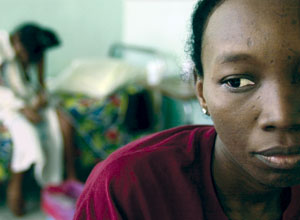
|
 |
| In Honduras, an estimated
16,000 people are HIVpositive,
including this
woman, whose health has
steadily declined, even after
being admitted to the
Catarino Rivas Hospital in
San Pedro Sula. |
|
Although the World Health Organization, the Joint United
Nations Programme on HIV/AIDS (UNAIDS) and other agencies
can’t pinpoint the numbers, they know HIV — the virus that
causes AIDS — and AIDS are cutting a swath across the world.
Approximately 1
million U.S. citizens have HIV/AIDS, but the disease is crushing sub-Saharan
Africa, where more than
half of the world’s estimated 40 million HIV carriers live. An estimated 7 million
HIV carriers live in Eurasia; India alone has at least 4 million people with
HIV/AIDS, and UNAIDS warns that number could balloon to 25 million by 2010.
As
the pandemic rages, countries are losing a generation of citizens and becoming
ripe for famine and economic and political instability — even in nuclear-capable
nations. What should
God’s people do about this disaster and the millions who suffer?
SPU’s AIDS Symposium
In November, Seattle Pacific hosted sociologist and nationally
acclaimed speaker Tony Campolo and REACH Ministries for an HIV/AIDS symposium.
Members of the greater Seattle community heard about the incurable disease that
some liken to the bubonic plague. And they were called to action, whether at
home or abroad.
Campolo opened the symposium in a chapel service dedicated to
today’s most poignant outcasts: children with HIV/
AIDS. “This is an opportunity for Christians to show off what the love of God
can do for people who suffer,” he exhorted.
He next joined a panel including
Tim Dearborn, dean of the chapel at Seattle Pacific; Robert Beilke, director
of the pediatric
psychology service at Mary Bridge Children’s Hospital; Mary Fairchok, chief of
pediatric infectious disease at Madigan Army Medical Center; and Pam Wenz, REACH
director of youth
services. That evening, Campolo again spoke on campus at a
citywide fund-raiser to support REACH’s ministry to children in the Northwest.
A local Christian organization begun in 1995, REACH serves children and families
living with HIV/AIDS through a mentor program, summer camp and worldwide prayer
network. “It was an honor to come to SPU to discuss HIV/AIDS,” says REACH Executive
Director Susan Slonaker. “The topic is controversial in many arenas, and I think
evangelicals — and I am one — don’t always know how to wrap their compassion
around it.”
When Dearborn learned the organization needed a venue, however, he
quickly invited them to campus. “This is exactly the kind of thing that we believe
we are here to address,” he says.
During the symposium, 73 students volunteered
to become
mentors for children living with HIV/AIDS in the Northwest. “Several students
came to me in tears, thanking us for putting this
event on,” says Dearborn. “AIDS had been a deep concern for
them, but they hadn’t found the place on campus to express it.”
Some First Reactions
to AIDS
AIDS first hit the American consciousness largely because thousands of
gay men were dying. As the disease exploded across the United States, those infected
were often ostracized — even disowned by families and fired from jobs. Many Christians
felt sympathy, but considered the illness remote, touching only homosexuals.
Some churches preached sermons about God’s
judgment on gays. “But the majority of illnesses Americans experience
are lifestyle-generated,” says Dearborn. “Do we want to say God custom-designed
lung cancer as a judgment on smokers?”
Most HIV/AIDS cases still occur through
sexual contact,
but the disease infects all ages, male and female, heterosexual
and homosexual. It can also be spread through reused needles,
in utero when a mother has AIDS and, in some parts of the
world, through tainted blood transfusions. Regardless of its
origin, those infected feel an enormous stigma, often refusing
to tell family, friends or church about their fight for survival.
And American Christians, like others, still show responses
toward people with HIV/AIDS that range from compassion to
indifference to judgment. “No one wants to touch them,” said
Campolo at SPU. “They are the contemporary lepers.”
Adds Richard Stearns, president
of the well-known Christian
relief organization World Vision, “Nearly 2,000 years after Jesus gave us the
parable of the Good Samaritan, we are still
asking the question, ‘Who is my neighbor?’ And we’re still getting the answer
wrong. This simple, yet most profound, parable speaks to the AIDS epidemic. Today,
it should challenge ... an American church that largely is ignoring the AIDS
pandemic.”
Bringing the Disease Home
In 1991, Dearborn’s friends, Martin and Kristi French, adopted a 1-year-old Romanian
boy who had been abandoned at birth outside a bleak hospital nine hours from
Bucharest. Once home with their new son, whom they named Jacob, the family began
regular trips to Seattle’s Children’s Hospital and Medical Center to evaluate
the child’s poor physical condition.
Soon they learned the unthinkable: Jacob
was HIV-positive. “I just crumbled — physically and emotionally,” Martin French
remembers. Doctors predicted Jacob would die within two years, but with medication
and love, he thrived. The reaction of the church, however, was unexpected.
During
the next 18 months, the Frenches visited several churches, seeking a congregation
to join. In each case, they
explained Jacob’s background and disease to the pastors. Repeatedly, they were
turned away. “Initially, we were somewhat
shocked,” says French. “People had a tenseness and a fear.
They didn’t know how to deal with it.”
Finally, a church cautiously opened its
doors to the family — and soon loved the little boy. “It was no longer a disease
they were
trying to figure out,” he says. “It was Jacob, a member of the body.”
Today,
Jacob is 12 years old, skilled at Tae Kwon Do and an
accomplished musician. “AIDS is awful,” says his father. “It stinks, and no one
wants to be a part of it. But either Jesus is
big enough to handle it — or he’s walked away from it, too.”
Other families have
also brought the AIDS crisis into the
pews. “I saw the reactions of many who were near my brother,” says LeRoy Hubbert,
facilities manager of SPU’s Blakely Island
campus. “The worst and best were from within the church.”
Hubbert didn’t learn
of his brother Bobby’s illness until 1994, nearly 10 years after he became HIV-positive.
Bobby hid the
virus from his family, speculating that he’d become infected during a medical
procedure in the late ’70s or early ’80s, when nonsexual transmission of AIDS
was poorly understood.
When LeRoy Hubbert learned Bobby was dying, he moved across
country to help care for him. There Hubbert witnessed firsthand the church’s
responses to his brother. Although church
leaders didn’t acknowledge Bobby’s need, he says, the laypeople
in the church “came through with flying colors.”
On the SPU campus, others have
replaced fears with human faces as well. Melody Rivera, a junior majoring in
theology and
educational ministries, traveled to South Africa two years ago. “It was life-changing
to meet people with the disease and to see
the extent of the AIDS tragedy,” she says. Before Autumn Quarter began, Rivera
helped organize the annual CityQuest, which dispatches new students into the
city for a day of service. She sent groups to three Seattle AIDS ministries.
Rivera also used a recent class assignment to address the AIDS calamity. In the
style of Old Testament prophets, she and classmates were asked to write modern-day
prophecies.
Through her paper, Rivera voiced a message from God:
“Woe to you whose heart
is not broken and contrite before your Maker, who ignore the plight of the innocents
of AIDS. ‘Are they not also created in my image?’ asks the Lord your God.”
— BY HOPE MCPHERSON
— PHOTOS BY
THE ASSOCIATED PRESS, JOHN KEATLEY AND REACH MINISTRIES
Back to the top
Back to Home |
 |

Click on images to enlarge.
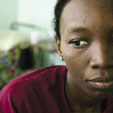
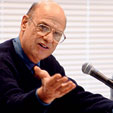

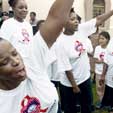
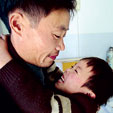

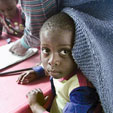
|
 |










